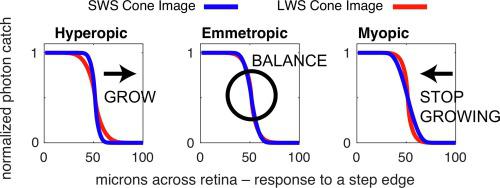当前位置:
X-MOL 学术
›
Vision Res.
›
论文详情
Our official English website, www.x-mol.net, welcomes your feedback! (Note: you will need to create a separate account there.)
An opponent dual-detector spectral drive model of emmetropization.
Vision Research ( IF 1.8 ) Pub Date : 2020-05-19 , DOI: 10.1016/j.visres.2020.03.011 Timothy J Gawne 1 , Thomas T Norton 1
Vision Research ( IF 1.8 ) Pub Date : 2020-05-19 , DOI: 10.1016/j.visres.2020.03.011 Timothy J Gawne 1 , Thomas T Norton 1
Affiliation

|
In post-natal developing eyes a feedback mechanism uses optical cues to regulate axial growth so as to achieve good focus, a process termed emmetropization. However, the optical cues that the feedback mechanism uses have remained unclear. Here we present evidence that a primary visual cue may be the detection of different image statistics by the short-wavelength sensitive (SWS) and long-wavelength sensitive (LWS) cone photoreceptors, caused by longitudinal chromatic aberration (LCA). We use as a model system the northern tree shrew Tupaia belangeri, diurnal cone-dominated dichromatic mammals closely related to primates. We present an optical model in which the SWS and LWS photoreceptors each represent an image at different levels of defocus. The model posits that an imbalance between SWS and LWS image statistics directs eye growth towards the point at which these image statistics are in balance. Under spectrally broadband ("white") lighting, the focus of the eye is driven to a target point approximately in the middle of the visible spectrum, which is emmetropia. Calculations suggest that the SWS cone array, despite the sparse number of SWS cones, can plausibly detect the wavelength-dependent differences in defocus and guide refractive development. The model is consistent with the effects of various narrow-band illuminants on emmetropization in tree shrews. Simulations suggest that common artificial light spectra do not interfere with emmetropization. Simulations also suggest that multi-spectral multi-focal lenses, where the different optical zones of a multifocal lens have different spectral filtering properties, could be an anti-myopia intervention.
中文翻译:

正视化的对手双探测器光谱驱动模型。
在出生后发育的眼睛中,反馈机制使用光学线索来调节轴向生长以实现良好的聚焦,这一过程称为正视化。然而,反馈机制使用的光学线索仍不清楚。在这里,我们提出的证据表明,主要视觉线索可能是由纵向色差 (LCA) 引起的短波长敏感 (SWS) 和长波长敏感 (LWS) 视锥光感受器检测到的不同图像统计数据。我们使用北方树鼩 Tupaia belangeri 作为模型系统,这是一种与灵长类动物密切相关的昼夜锥体主导的双色哺乳动物。我们提出了一个光学模型,其中 SWS 和 LWS 光感受器分别代表不同散焦水平的图像。该模型假定 SWS 和 LWS 图像统计数据之间的不平衡将眼睛的生长引导至这些图像统计数据处于平衡的点。在光谱宽带(“白色”)照明下,眼睛的焦点被驱动到大约位于可见光谱中间的目标点,即正视眼。计算表明,尽管 SWS 锥体数量稀少,但 SWS 锥体阵列可以合理地检测散焦和引导折射发展中与波长相关的差异。该模型与各种窄带光源对树鼩正视化的影响一致。模拟表明,常见的人造光谱不会干扰正视化。模拟还表明,多光谱多焦镜头,
更新日期:2020-05-19
中文翻译:

正视化的对手双探测器光谱驱动模型。
在出生后发育的眼睛中,反馈机制使用光学线索来调节轴向生长以实现良好的聚焦,这一过程称为正视化。然而,反馈机制使用的光学线索仍不清楚。在这里,我们提出的证据表明,主要视觉线索可能是由纵向色差 (LCA) 引起的短波长敏感 (SWS) 和长波长敏感 (LWS) 视锥光感受器检测到的不同图像统计数据。我们使用北方树鼩 Tupaia belangeri 作为模型系统,这是一种与灵长类动物密切相关的昼夜锥体主导的双色哺乳动物。我们提出了一个光学模型,其中 SWS 和 LWS 光感受器分别代表不同散焦水平的图像。该模型假定 SWS 和 LWS 图像统计数据之间的不平衡将眼睛的生长引导至这些图像统计数据处于平衡的点。在光谱宽带(“白色”)照明下,眼睛的焦点被驱动到大约位于可见光谱中间的目标点,即正视眼。计算表明,尽管 SWS 锥体数量稀少,但 SWS 锥体阵列可以合理地检测散焦和引导折射发展中与波长相关的差异。该模型与各种窄带光源对树鼩正视化的影响一致。模拟表明,常见的人造光谱不会干扰正视化。模拟还表明,多光谱多焦镜头,


























 京公网安备 11010802027423号
京公网安备 11010802027423号